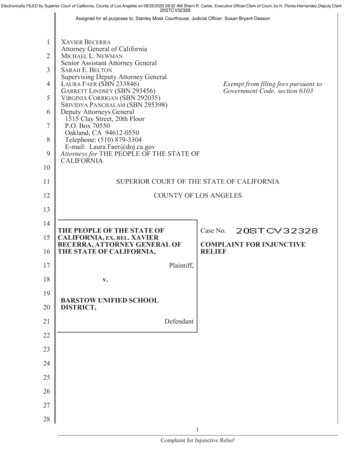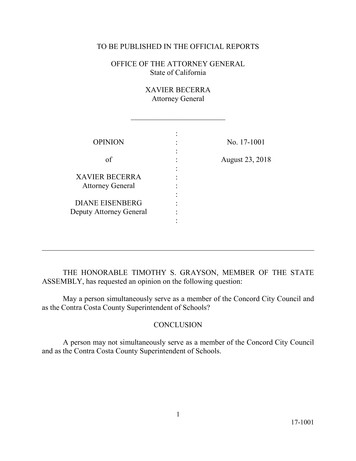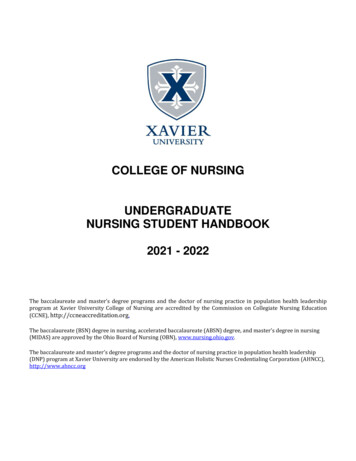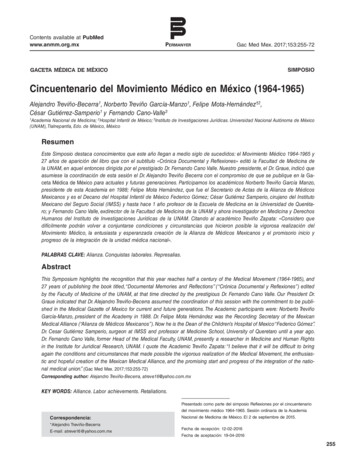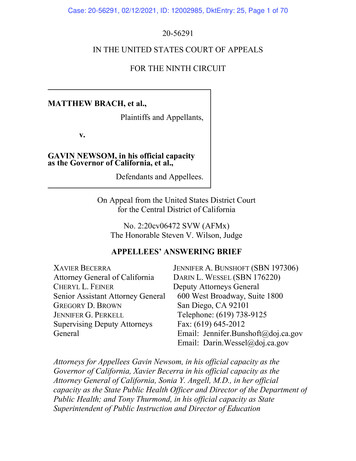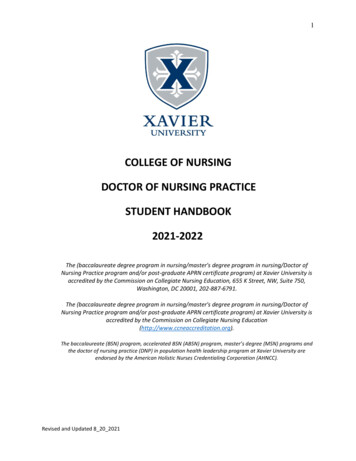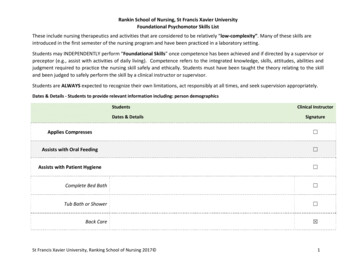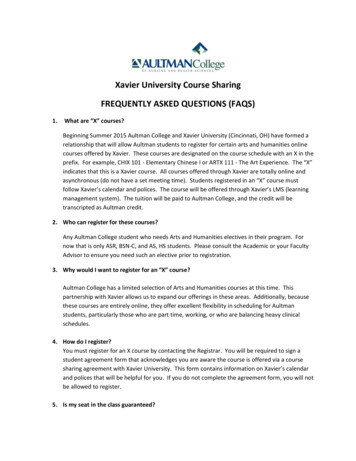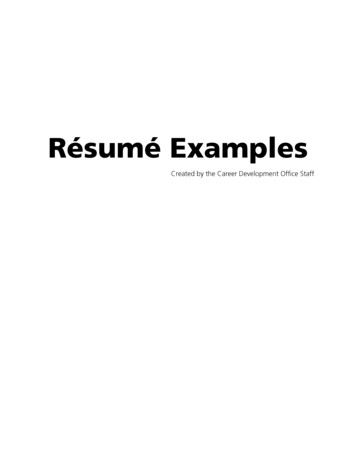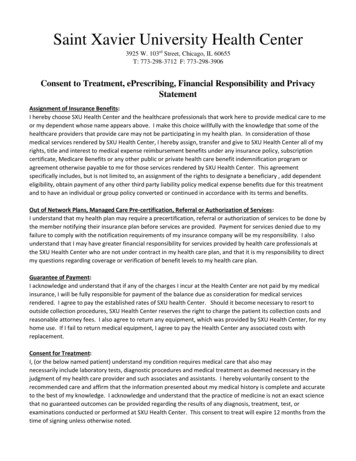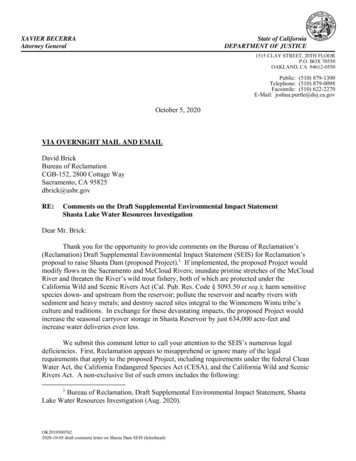
Transcription
XAVIER BECERRAAttorney GeneralState of CaliforniaDEPARTMENT OF JUSTICE1515 CLAY STREET, 20TH FLOORP.O. BOX 70550OAKLAND, CA 94612-0550Public: (510) 879-1300Telephone: (510) 879-0098Facsimile: (510) 622-2270E-Mail: joshua.purtle@doj.ca.govOctober 5, 2020VIA OVERNIGHT MAIL AND EMAILDavid BrickBureau of ReclamationCGB-152, 2800 Cottage WaySacramento, CA 95825dbrick@usbr.govRE:Comments on the Draft Supplemental Environmental Impact StatementShasta Lake Water Resources InvestigationDear Mr. Brick:Thank you for the opportunity to provide comments on the Bureau of Reclamation’s(Reclamation) Draft Supplemental Environmental Impact Statement (SEIS) for Reclamation’sproposal to raise Shasta Dam (proposed Project).1 If implemented, the proposed Project wouldmodify flows in the Sacramento and McCloud Rivers; inundate pristine stretches of the McCloudRiver and threaten the River’s wild trout fishery, both of which are protected under theCalifornia Wild and Scenic Rivers Act (Cal. Pub. Res. Code § 5093.50 et seq.); harm sensitivespecies down- and upstream from the reservoir; pollute the reservoir and nearby rivers withsediment and heavy metals; and destroy sacred sites integral to the Winnemem Wintu tribe’sculture and traditions. In exchange for these devastating impacts, the proposed Project wouldincrease the seasonal carryover storage in Shasta Reservoir by just 634,000 acre-feet andincrease water deliveries even less.We submit this comment letter to call your attention to the SEIS’s numerous legaldeficiencies. First, Reclamation appears to misapprehend or ignore many of the legalrequirements that apply to the proposed Project, including requirements under the federal CleanWater Act, the California Endangered Species Act (CESA), and the California Wild and ScenicRivers Act. A non-exclusive list of such errors includes the following:1Bureau of Reclamation, Draft Supplemental Environmental Impact Statement, ShastaLake Water Resources Investigation (Aug. 2020).OK20193007622020-10-05 draft comment letter on Shasta Dam SEIS (letterhead)
David BrickBureau of ReclamationOctober 5, 2020Page 2A. Reclamation cannot rely on Clean Water Act section 404(r) (33 U.S.C. § 1344(r)) toapprove the proposed Project and must obtain Clean Water Act permits from the StateWater Resources Control Board (SWRCB) before implementing the proposed Project.B. Reclamation must consult with Native American tribes, including the Winnemem Wintutribe, and fully address impacts to cultural resources.C. Reclamation misinterprets state-law protections for the McCloud River and the River’swild trout fishery and no exception exists for Reclamation to seek any state agencyassistance with its efforts to raise Shasta Dam.D. Reclamation must analyze whether the proposed Project will be consistent with allapplicable state laws.E. Reclamation must consult with the U.S. Fish and Wildlife Service (FWS) and theNational Marine Fisheries Services (NMFS) before proceeding with the proposed Projectbecause it will likely cause significant harm to endangered and threatened species.Second, the SEIS fails to comply with the National Environmental Policy Act (NEPA)for the following reasons:A. Reclamation must address state agencies’ comments submitted during earlier iterations ofthe proposed Project’s environmental review.B. The SEIS fails to adequately analyze and disclose impacts to sensitive species in theregion, including western yellow-billed cuckoo, several listed fish species, and Shastasnow-wreath.C. The SEIS fails to adequately analyze mitigation measures for wetland impacts associatedwith the proposed Project.As discussed in detail below, Reclamation must correct the legal defects in the SEIS orwithdraw the proposed Project. 22The Attorney General submits these comments on the proposed Project based on hisindependent power and duty to protect the environment and natural resources of the State. SeeCal. Const., art. V, § 13; Cal. Gov. Code §§ 12511, 12600-12612; D’Amico v. Bd. of MedicalExaminers, 11 Cal.3d 1, 14-15 (1974).
David BrickBureau of ReclamationOctober 5, 2020Page 3BACKGROUNDI.Raising Shasta Dam Would Result in Nominal Increases to the Water Supply andSignificant Impacts to Fish and Wildlife, Water Quality, and Tribal Sacred Sites,Among Other Impacts.Reclamation’s present effort to raise Shasta Dam began in 2006 when Reclamationreleased a Public Scoping Report and six years later released a Draft Feasibility Report.Reclamation initiated the NEPA process when it circulated a Draft and Final EIS that examinedseveral proposed Project alternatives for raising Shasta Dam (6.5, 12.5, or 18.5 feet). See Bureauof Reclamation, Shasta Lake Water Resources Investigation, Draft Environmental ImpactStatement (2013) (2013 Draft EIS); Bureau of Reclamation, Shasta Lake Water ResourcesInvestigation, Final Environmental Impact Statement (2015) (2015 Final EIS). The Final EISidentified the preferred alternative of raising the dam 18.5 feet. 2015 Final EIS at S-32 to S-34.The SEIS notes that raising the dam 18.5 feet would increase the seasonal carryoverstorage in Shasta Reservoir by only 634,000 acre-feet. SEIS at 4-2, 5-34. The dam raise alsowould modify flows in the Sacramento and McCloud Rivers and flood 5,000 acres of habitat. Inaddition, the proposed Project would cost more than 1.3 billion and increase water available fordelivery by only 51,300 acre-feet per year.3The SEIS overestimates the potential benefits the proposed dam raise would have toanadromous fish and water supply deliveries, and underestimates the threat of significant harmthe proposed Project would have to water quality, fish and wildlife, and tribal sacred sites,among other impacts.The proposed Project would pollute the reservoir and nearby rivers with heavy metalsand sediment. The proposed Project would increase mercury (from shuttered mining sites),3In 2016, Congress enacted the Water Infrastructure Improvements for the Nation(WIIN) Act, which requires at least a fifty-percent contribution from non-federal cost-sharingpartners for the Shasta Dam raise and Reservoir expansion. WIIN Act, Pub. L. No. 114-322(2016). The WIIN Act also requires compliance with all applicable federal and stateenvironmental laws. Pub. L. No. 114-322, §§ 4007(b)(4), 4007(j), 4012. In March 2018,Congress approved 20 million in WIIN Act funding for pre-construction and design engineeringto raise Shasta Dam. For 2020, the Secretary of the Interior asked for 57,000,000 for the ShastaDam and Reservoir Enlargement Project. See Letter from Timothy R. Petty, Ph.D., AssistantSecretary for Water and Science, to Representative Marcy Kaptur, Chairwoman of theSubcommittee on Energy and Water Development, Committee on Appropriations (Feb. 13,2019) available at loads/attachment/pdf/200b398511/WIIN FY 18 Funding Congress Letter 2-13-19.pdf. Congressstruck that funding request. See Further Consolidated Appropriations Act, Pub. L. No. 116-94,133 Stat. 2534, 2665-67 (2020).
David BrickBureau of ReclamationOctober 5, 2020Page 4copper, zinc, and other pollutants associated with sediment in the Shasta and Keswick Reservoirsand downstream in the Sacramento River. Increased mercury loading into Shasta Reservoircould increase the mercury levels in fish and invertebrates in the lake and then bio-accumulate insensitive bird species that feed on fish. Shasta Lake is a popular camping, boating, and fishingdestination, see 2015 Final EIS 1-3, 1-35, 18-1 through 18-3, and for several years, the CaliforniaOffice of Environmental Health Hazard Assessment (OEHHA) has advised women and childrento reduce their consumption of fish caught from Shasta Lake because the mercury levels couldharm the brain and development in fetuses, babies, and children. See OEHHA, InformationAbout Eating Fish from Shasta Lake (2017) (attached as Exhibit 1); see also OEHHA, HealthAdvisory and Guidelines for Eating Fish from Shasta Lake 18-22 (2017) (attached as Exhibit 2).OEHHA recommends children and women between 18 and 45 consume only one serving or lessper week of black bass, carp, catfish, or Chinook salmon caught in Shasta Reservoir. Increasedmercury associated with the proposed Project could render these fish species too toxic for humanconsumption.Increased loading of toxic metals into Shasta Reservoir may affect the KeswickReservoir’s ability to dilute acid mine drainage from the Iron Mountain Mine Superfund site.This may result in increased loading of heavy metals into spawning habitat in the SacramentoRiver and further downstream into the Delta. Increased sedimentation and turbidity associatedwith the proposed Project would impact growth, survival, and reproductive success of aquaticorganisms. Sediment exposure harms include reduced visual capacity, reduced feeding, andreduced tolerance to disease. Increased turbidity would affect fish locating and feeding on prey.The proposed Project also would reduce flows and degrade riparian habitat qualitycritical to the survival of yellow-billed cuckoo and Shasta snow-wreath. Only about 23 to 25breeding pairs of yellow-billed cuckoo occur on the Sacramento River between Red Bluff andColusa. Proposed Project implementation would accelerate the loss of this breeding population.Shasta snow-wreath is an understory shrub endemic to the southeastern Klamath Mountains innorthern California. Shasta snow-wreath is a candidate for endangered species protection underCESA. The proposed dam raise would fragment the remaining populations of Shasta snowwreath; in all, forty-six percent of the known snow-wreath population would be lost by raisingShasta Dam. Additionally, the proposed dam raise could harm many other sensitive species inthe proposed Project area, including Pacific fishers, bald eagles, western purple martin, Shastasalamander, and Shasta huckleberry.The proposed Project also would inundate 60 acres of the McCloud River and increasereservoir levels above the McCloud River Bridge, which would convert part of the McCloudRiver into reservoir habitat. Inundating stretches of the McCloud River could make it ineligiblefor listing—and ultimately protection—under the California Wild and Scenic Rivers Act. TheCalifornia Department of Fish and Wildlife (CDFW) has designated the McCloud River a WildTrout stream, an aesthetically pleasing and environmentally productive stream managedexclusively for wild trout. The Shasta Dam raise would inundate miles of wild trout habitat inthe McCloud River and destroy spawning habitat. See Section II.B. below for a review of
David BrickBureau of ReclamationOctober 5, 2020Page 5comments submitted by Russell Liebig, Greg Pasternack and G. Mathias Kondolf, and BruceHerbold, discussing how the harm to riparian species and habitat associated with raising ShastaDam will be much more severe than Reclamation acknowledges.Last, the proposed Project would significantly impact tribal sacred and cultural sites,including sites important to the Winnemem Wintu tribe. The Winnemem Wintu is a nonfederally recognized, native California tribe that has long opposed the proposed Project. TheWinnemem Wintu’s traditional territory included the east and west sides of the upperSacramento River watershed, the McCloud River and Squaw Creek watersheds, andapproximately 20 miles of the Pit River. Presently, the Winnemem Wintu tribe includes about125 members, many of whom live in a 42-acre village. Shasta Dam and Reservoir’s originalconstruction submerged about ninety percent of the Winnemem Wintu’s village, sacred, burial,and cultural gathering sites, and Reclamation’s proposed Project would eliminate much of theremainder by inundating around 20 sacred Winnemem Wintu sites, including a burial ground andprayer rock. The Shasta Dam and Reservoir’s original construction also eliminated the Chinooksalmon runs essential to Winnemem Wintu diet and culture.II.Federal and State Agencies Previously Determined Raising Shasta Dam WouldHave Almost None of the Benefits Reclamation Claims.Reclamation has represented that raising Shasta Dam would make more cold wateravailable to support anadromous fish downstream in the Sacramento River. However, duringearlier iterations of Reclamation’s NEPA process, FWS and state agencies commented that theproposed Project would result in negligible or slightly negative impacts to Chinook salmonsurvival. See Letter from FWS to Regional Director, U.S. Bureau of Reclamation, at 3 (Sept. 20,2013) (2013 FWS Letter) (attached as Exhibit 3); see also Letter from CDFW to Bureau ofReclamation, Planning Division (Sept. 30, 2013) (2013 CDFW Letter) (attached as Exhibit 4).In ninety percent of years, there would be no benefit to anadromous fish survival. See FWS,Coordination Act Report for the Shasta Lake Water Resources Investigation (2015) (2015 FWSReport) at viii (attached as Exhibit 5). The benefits of an enlarged cold-water pool for Chinooksalmon runs are limited to only six to sixteen percent of water years. See id. Instead ofbenefitting anadromous fish, the proposed Project would degrade fish habitat in the SanFrancisco Bay-Delta, including habitat for listed Delta smelt, California-listed longfin smelt,juvenile salmon, and California Central Valley steelhead. See 2013 CDFW Letter at 3, 5.FWS concluded in 2015 that the proposed Project would not provide substantial benefitsto fish and wildlife resources and would result in losses of salmonid rearing and riparian habitat.See 2015 FWS Report at viii, xiii. FWS also took issue with Reclamation’s modeling. See 2013FWS Letter at 2; 2015 FWS Report at ix. FWS stated that the modeling used in the Draft EISdid not account for population trends over time or for downstream habitat conditions. See 2013FWS Letter at 2-3. Also, only a few of the 82 water years modeled showed any benefits toanadromous fish from Shasta Dam’s enlargement. See id. at 3. Further, FWS noted that otherfactors beyond increasing the cold water pool, such as improved access to important rearing
David BrickBureau of ReclamationOctober 5, 2020Page 6habitat for juvenile salmon, restoration of downstream fish habitats, the screening of intakes toeliminate fish entrainment, and flow management, would have more substantial effects on thelong-term viability of anadromous fish in the Sacramento River. See id. Importantly, FWSdetermined water management that would accompany Shasta Dam’s enlargement woulddecrease the inundation flows that provide juvenile salmon access to important rearing habitatand benefit other fish species, such as the Sacramento splittail and Delta and longfin smelt. Seeid. at 3-4.CDFW and the Central Valley Regional Water Quality Control Board (CVRWQCB) alsosubmitted comments on the Draft EIS. See 2013 CDFW Letter; see also Letter fromCVRWQCB to Bureau of Reclamation (Sept. 11, 2013) (2013 CVRWQCB Letter) (attached asExhibit 6). CDFW commented that the proposed Project would result in minimal benefits foranadromous fish and cause “significant and unavoidable impacts to fish, wildlife, native plants,and natural communities.” 2013 CDFW Letter at 1. The CVRWQCB commented that theproposed Project would have significant and unavoidable impacts on water quality causedprimarily by increased sediment. See CVRWQCB Letter at 1, 3.III.Raising Shasta Dam Would Cause Damage Cumulative to that Caused by Adoptionof the FWS and NMFS Biological Opinions.The harm to fish species caused by raising Shasta Dam would be cumulative to thedamage already caused by the adoption of the FWS and NMFS 2019 Biological Opinions(BiOps) for the Central Valley Project. In August 2016, Reclamation requested reinitiation ofconsultation on an FWS 2008 BiOp and a NMFS 2009 BiOp on the Long-Term Central ValleyProject and State Water Project Operations Criteria and Plan. The 2008 and 2009 BiOps foundthat the Central Valley Project and State Water Project operations would jeopardize thecontinued existence of listed species, including endangered Sacramento River winter-runChinook salmon, threatened Delta smelt, and threatened Central Valley steelhead, and woulddestroy or adversely modify these species’ designated critical habitat. See FWS, BiologicalOpinion on the Proposed Coordinated Operations of the Central Valley Project and State WaterProject at 276, 278 (2008), available at https://www.fws.gov/sfbaydelta/Documents/SWPCVP OPs BO 12-15 final OCR.pdf; see also NMFS, Biological Opinion and ConferenceOpinion on the Proposed Long-Term Operations of the Central Valley Project and State WaterProject at 30 (2009), available at s/Central 0and%20Plan/nmfs biologicaland conference opinion on the long-term operations of the cvp and swp.pdf. The 2008and 2009 BiOps therefore placed restrictions on the amount of water exported via the StateWater Project and the Central Valley Project Delta pumps in order to protect listed fish and theircritical habitat. See 2008 FWS BiOp at 279-95, 360-63; 2009 NMFS BiOp at 575-726.In 2019, FWS and NMFS issued revised BiOps. Together, the BiOps allow Reclamationto change the flow regime for the Central Valley Project in a way that threatens harm to speciesin the Sacramento River and San Francisco Bay Delta downstream from Shasta Dam. See FWS,
David BrickBureau of ReclamationOctober 5, 2020Page 7Biological Opinion for the Reinitiation of Consultation on the Coordinated Operations of theCentral Valley Project and State Water Project at 393-401 (2019) (2019 FWS BiOp), availableat 0182019 ROC BO final.pdf; see alsoNMFS, Biological Opinion on the Long-Term Operation of the Central Valley Project and StateWater Project at 14-19 (2019) (2019 NMFS BiOp), available at 22046. The 2019 BiOps, however, do not authorize impacts to listed speciesassociated with the proposed Shasta Dam raise. The BiOps represent that “effects of theconstruction of [the Shasta Dam] raise are being addressed in a separate section 7 consultation”with the wildlife agencies. 2019 FWS BiOp at 404; 2019 NMFS BiOp at 203 n.8.COMMENTS ON THE DRAFT SUPPLEMENTAL EISI.Reclamation Misapprehends or Ignores Legal Requirements for the ProposedProject.As an initial matter, Reclamation appears to misapprehend or ignore legal requirementsthat apply to the proposed Project. Reclamation must comply with all applicable state andfederal laws before it can lawfully raise Shasta Dam.A.Reclamation Must Obtain Clean Water Act Permits from the SWRCB BeforeImplementing the Proposed Project.The SEIS suggests that the proposed Project is exempt from Clean Water Act (CWA)permit requirements, in contrast to various and consistent statements in the Final EISacknowledging permitting requirements under CWA Sections 401 and 404. See SEIS at 3-1;2015 Final EIS at 1-29, 1-31. Specifically, in the Final EIS, Reclamation determined that theproposed Project’s potential to affect Shasta Reservoir’s water quality would requireReclamation to prepare and submit a request for CWA Section 401 water quality certification tothe CVRWQCB. 2015 Final EIS at 7-32. Reclamation also repeatedly acknowledged in theFinal EIS that it must work closely with federal and state agencies to ensure compliance with the“CWA (e.g. Section 401 and 404)[.]” 2015 Final EIS at 7-82, 7-131, 7-175.Now, Reclamation inexplicably and without justification contradicts its prior statementson CWA requirements. Reclamation now seeks to rely on CWA 404(r), stating in the SEIS that“[it] will comply with CWA 404(r) and will not separately obtain permits under CWA Sections401, 402, and 404[.]” SEIS at A-1. According to the SEIS, “[b]y following CWA 404(r)Reclamation is not subject to CWA 404(r) regulations under CWA 402 if information on theeffects of discharge . . . are included in an EIS.” SEIS at 3-1.Reclamation misinterprets CWA section 404(r). Section 404(r)’s exemption is limited tothe discharge of dredged or fill material that is part of a “Federal project specifically authorizedby Congress.” 33 U.S.C. § 1344(r). As to all other discharges, Reclamation must comply withthe CWA, including by obtaining permits from state permitting agencies.
David BrickBureau of ReclamationOctober 5, 2020Page 8Section 404(r) provides that “[t]he discharge of dredged or fill material as part ofthe construction of a Federal project specifically authorized by Congress” is not subjectto most Clean Water Act permitting requirementsif information on the effects of such discharge, including consideration of theguidelines developed under subsection (b)(1) of this section, is included in an[EIS] for such project . . . and such [EIS] has been submitted to Congress beforethe actual discharge of dredged or fill material in connection with the constructionof such project and prior to either authorization of such project or anappropriation of funds for such project.33 U.S.C. § 1344(r). By its plain language, Section 404(r) does not apply to the proposed Projectbecause it has not been “specifically authorized by Congress”—a fact Reclamation’s DeputyDirector has admitted. See Winnemem Wintu Tribe v. U.S. Dep’t of Interior, 725 F.Supp.2d1119, 1145 (E.D. Cal. 2010) (declaring “Reclamation is not congressionally authorized to movebeyond the feasibility study phase and actually increase Shasta Reservoir storage by raisingShasta Dam”). To the contrary, Congress has appropriated only 20 million under the WIIN Actfor Reclamation to study this proposal—far short of the estimated 1.3 billion required for fullproposed Project build out. See Del. Dep’t of Nat. Res. and Envtl. Control v. U.S. Army Corps ofEng’rs, 685 F.3d 259, 280-82 (3d Cir. 2012) (noting “to trigger Section 404(r), there must be afederal project specifically authorized by Congress,” and “funds must be appropriated for projectconstruction”); see also Bd. of Miss. Levee Comm’rs v. U.S. EPA, 785 F.Supp.2d 592, 612-13(N.D. Miss. 2011) (noting plaintiff must invoke the appropriate Congressional authorizationprocess, including evidence Congress received, evaluated, and approved an EIS).Further, even if Section 404(r) applies, it does not waive all CWA permit requirements.Rather, Section 404(r) waives CWA permit requirements only for water quality impacts causedby “[t]he discharge of dredged or fill material,” not by the many other potential dischargesassociated with the proposed Project. 33 U.S.C § 1344(r).4The SEIS also does not provide a full analysis of the section 404(b)(1) guidelines, assection 404(r) requires. See 33 U.S.C. § 1344(r). The section 404(b)(1) guidelines, codified at40 C.F.R. pt. 230, set out detailed requirements for the discharge of dredged or fill material4The Section 404(r) exemption is very narrow, and not applicable here. “The narrownature of this exemption is underscored by the fact that it applies only to discharges integral toconstruction of designated federal projects. [Citation Omitted.] . . . . ‘The conferees did notintend to exempt other discharges which may be associated generally with constructing Federalprojects, but which are ancillary to the specific activities submitted to and approved byCongress’ [Citation Omitted.]” Monongahela Power Co. v. Marsh, 809 F.2d 41, 51 n. 9 (D.C.Cir. 1987). Reclamation’s reading of Section 404(r) would have the narrow exemption swallowthe rule.
David BrickBureau of ReclamationOctober 5, 2020Page 9pursuant to section 404. See 40 C.F.R. § 230.10(a). Among other things, the guidelines requireagencies to evaluate whether a discharge will “[c]ause[] or contribute[] to violations of anyapplicable State water quality standards”; “[j]eopardize[] the continued existence” of anythreatened or endangered species”; cause significant adverse effects to “human health orwelfare,” including but not limited to effects on “municipal water supplies, plankton, fish,shellfish, wildlife, and special aquatic sites”; cause significant adverse effects to “aquaticecosystem diversity, productivity, and stability”; or cause significant adverse effects to“recreational, aesthetic, and economic values.” 40 C.F.R. § 230.10(b), (c). Neither the SEIS northe 2015 Final EIS provides this detailed analysis.Even if Reclamation could rely on section 404(r)—which it cannot—Reclamation muststill comply with California state regulations governing the discharge of dredged and fillmaterial. Under CWA section 404(t), California state agencies have authority to “control thedischarge of dredged or fill material in any portion of the navigable waters within the jurisdictionof” the state, “including any activity of any Federal agency.” 33 U.S.C. § 1344(t). Federalagencies must therefore “comply with such State . . . requirements both substantive andprocedural . . . to the same extent that any person is subject to such requirements.” Id.; see alsoFriends of the Earth v. U.S. Navy, 841 F.2d 927, 934-35 (9th Cir. 1988).Reclamation must discuss such state regulations and demonstrate how the proposedProject will comply with them. See 40 C.F.R. § 1506.2. Applicable regulations include the newdredge and fill regulations the SWRCB adopted in 2019, which set out detailed procedures forthe discharge of dredged or fill material to state waters. See SWRCB, State Wetland Definitionand Procedures for Discharges of Dredged or Fill Material to Waters of the State (Apr. 2, 2019)(attached as Exhibit 7).Reclamation is not, as the SEIS suggests, exempt from all “permits under CWA Sections401, 402, and 404.” SEIS at A-1. To address this flaw, the SEIS should evaluate the CWApermits it will need to obtain for all proposed discharges, whether or not Congress “specificallyauthorize[s]” the proposed dam raise. Those include permits related to the discharge of dredgedor fill material; discharges and groundwater dewatering caused by new constructionaccompanying the dam raise; discharges from maintenance of supply wells and pipelines;discharges from well development; and other point-source discharges. SEIS at 3-1 through 3-6.B.Reclamation Must Consult with Tribes and Fully Analyze Impacts to WinnememWintu and Other Tribal Sacred Sites.As discussed, raising Shasta Dam will cause significant and permanent harm to tribalsacred and cultural sites, including sites that are important to the Winnemem Wintu tribe.Reclamation must consult with tribes and comply with the National Historic Preservation Act(NHPA) regarding impacts to tribal sacred sites before proceeding with any work to raise ShastaDam.
David BrickBureau of ReclamationOctober 5, 2020Page 10The NHPA requires federal agencies, before approving a proposed federal “undertaking,”to “take into account the effect of the undertaking on any historic property,” 54 U.S.C. § 306108,including by consulting with tribes, see 54 U.S.C. § 306102(b)(4).The 2015 Final EIS acknowledges that “a considerable number of Traditional CulturalProperties and other areas of special concern” are likely “present in the study area.” 2015 FinalEIS at 14-19. The Winnemem Wintu in particular have repeatedly raised concerns about impactsto their sacred sites, many of which will be inundated if Reclamation raises the level of ShastaReservoir. 2015 Final EIS at 14-24, 24-4.Construction of the original Shasta Dam flooded nearly 27 miles of the McCloud River,including a significant portion of the Tribe’s ancestral homeland. Reclamation’s proposal toraise the dam would compound that historical harm. For example, the proposed Project wouldinundate Balas Son or Puberty Rock, which is the site of an important coming-of-age ritual foryoung women in the Winnemem Wintu tribe. Letter from the Winnemem Wintu Tribe to TribalCouncil Representatives Regarding Resolution Opposing the Proposed Raise of Shasta Dam at 2(Sept. 12, 2020) (attached as Exhibit 8). The dam raise would also submerge important“gathering areas, village sites,” and burial sites, “as well as habitat essential to [the Tribe’s]salmon restoration efforts.” Id. By the Tribe’s estimate, “nearly all of the tribe’s remaining siteswould be put permanently underwater with the reservoir’s expansion.” Craig Miller, ShastaDam Project Sets up Another Trump-California Showdown, KQED (Jan. 28, 2019) (attached asExhibit 9); see also 2015 Final EIS at 14-24 (“The Winnemem Wintu have estimated that 120ancestral villages still accessible above the current high waterline of Shasta Lake would beadversely impacted” by the proposed dam raise.).Raising Shasta Dam also would threaten other tribal sites, including villages and burialgrounds identified by the Pit River Madesi Band. 2015 Final EIS at 24-5. Reclamation mustconsult with all tribes that the dam raise may affect and provide a full accounting of impacts totribal cultural and sacred sites before it moves forward with the proposed Project.The 2015 Final EIS represents that Reclamation would mitigate these impacts butprovides no information about what those mitigation measures might entail. 2015 Final EIS at14-33 through 14-36. Reclamation further concedes that “it is unlikely that adequate mitigationis available to reduce the impact” to sacred and cultural sites “to a less-than-significant level.”2015 Final EIS at 14-24 through 14-25.Reclamation asserts in the 2015 Final EIS that it is not yet required to comply withNHPA requirements because to date Reclamation has only completed “nondestructive projectplanning” activities. 2015 Final EIS at 14-16. Nevertheless, given the potentially severe impactsto tribal sacred sites, Reclamation must begin the NHPA consultation process as soon as possibleto ensure that such impacts are given due weight. The Attorney General submits that theirreversible harm to tribal sacred and cultural sites should be a substantial, if not a dispositive,consideration as Reclamation decides whether to move forward with this proposal.
David BrickBureau of ReclamationOctober 5, 2020Page 11C.Reclamation May N
Oct 5, 2020
